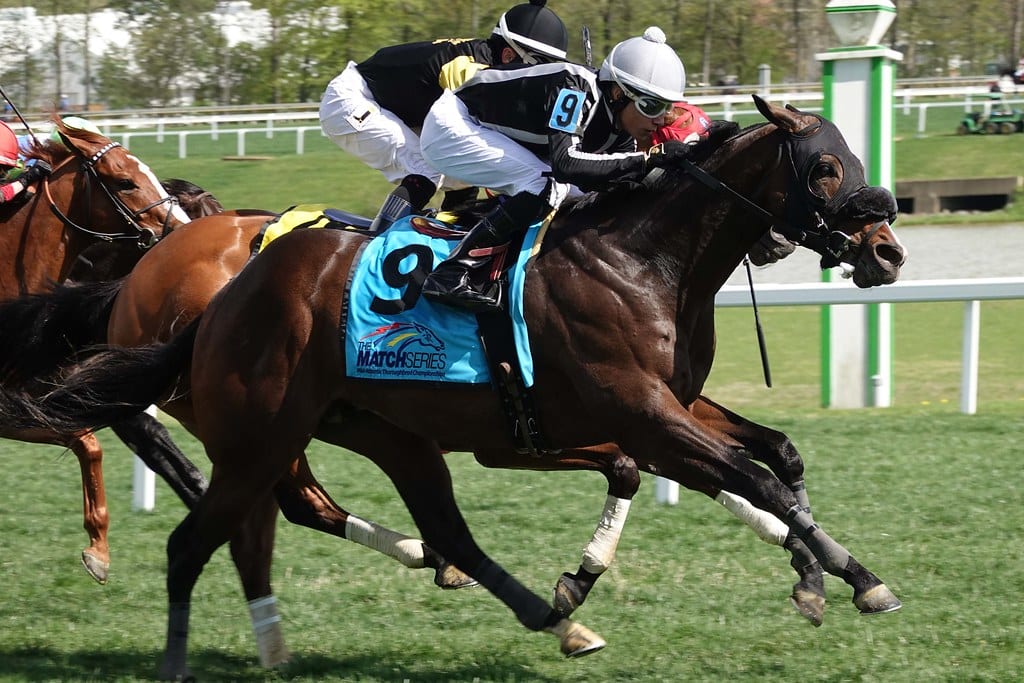In with the old as Teletimer returns at Laurel Park

Dirty set a 5 1/2-furlong track record that lasted for about six weeks. Photo by Allison Janezic.
Jack Harmon has timed a lot of races.
Harmon, who works for American Teletimer Corp., became the clocker at Laurel Park in 1971 and Pimlico in ’76. He’s timed four Triple Crown winners and was called as an expert witness when in 2012 Penny Chenery successfully lobbied the Maryland Racing Commission to change the time of Secretariat’s 1973 Preakness to 1:53 flat – the stakes record.
But even he had never seen anything quite like the bevy of track records Laurel Park experienced between February 3 and June 8. In all, seven of Laurel’s course records were set within that period, and three of those were set twice, meaning that 10 times in four months, a new course record was set.
Why?
One reason is that both Laurel’s dirt and turf courses have played significantly faster this year than in most prior years.
But another is that Harmon and Teletimer were not the official timers. Instead, the Maryland Jockey Club was – from mid-December through mid-June – employing an Equibase-developed global positioning satellite (GPS) system as its official timer. The Equibase system was not in use as the official timer during the Pimlico meeting.
Harmon continued to run the Teletimer system – and to time races by hand – as backups and to compare to the new Equibase system. And he found that the GPS system recorded times that were consistently faster than those logged by Teletimer.
“There was quite a few times when they were off up to like three-fifths of a second,” Harmon said. “Most of the time, it was off a fifth-and-a-half or two.”
That there could be problems was almost immediately apparent. Harmon kept a record of the times, every race and every day. In the second race of December 14, 2018 – the first day of the experiment – the Equibase timing system returned a time of 1:10.19 for six furlongs. That was 0.66 seconds faster than the 1:10.85 that Teletimer recorded.
“Equibase is telling me they’re 95 percent within 0.6 seconds, and I said, ‘That’s three lengths!’” said Maryland Jockey Club president Sal Sinatra, who made the decision in mid-June to return to the older system “for the time being.”
The attraction of the Equibase system is that, when fully operational, it should provide data and visual enhancements similar to the Trakus system in operation at many racetracks. The latter provides both detailed information on each horse in a race – how many feet the horse traveled, the horse’s time to each point of call – and visual enhancements like “chicklets” on the screen. These can be invaluable to handicappers and horsemen.
But of course, getting the running time correct is the baseline requirement.
And while the Teletimer system is determinedly old-school, officials are confident – for now – that its times are more accurate. In brief, the Teletimer system involves a series of poles erected around the racetrack that emit an invisible beam. Using a console, an operator alerts the system to the distance and surface of the race being run, which then activates the proper poles. When horses cross those beams, the time is recorded.
Harmon’s hand-timing of the races provided an extra measure of confidence, and his times were consistently roughly equal to the Teletimer numbers.
On the final weekend that the Equibase system served as the official timer, it recorded faster times than did Teletimer in 30 of 32 races, with the gap as high as 0.72 seconds. The average difference was 0.26 seconds.
While that may not sound like much, that’s equivalent to more than a length – easily the distance between winning and losing, or setting a track record, or not.
While eight of the 10 new records – including all three that were broken twice – were on turf, the first came on dirt. That was February 3, when Correjon went 6 ½ furlongs in 1:15.07. At the time it seemed easy enough to dismiss; it was an unusual distance that hadn’t been run in years.
But then came late April. Four records fell between April 20 and April 28. One of those – 5 ½ furlongs on the turf with the rail set at 70 feet (Exceller course) – had stood since 2007.
And then in the first week of June, five more records fell, four of them on the turf.
In all 10 of the record-setting performances, the Equibase timing system recorded a faster time than did Teletimer. The average difference of the 10 was 0.27 seconds.
Had Teletimer remained the timing system during the period, two of the seven new records – both on the turf – would not have been shattered. And of the three broken twice, two would have been eclipsed just once, and the third would not have been surpassed at all.
That five records would have fallen with either timing system speaks to how fast the tracks have been. But that five other record-setting performances should not have been is one reason that Teletimer is back.
“I don’t think they realize it’s a domino effect,” Sinatra said. “I get the horsemen going, ‘The turf course is concrete. That guy [track super] doesn’t know what he’s doing.’ And that’s not the case.”
So for the time being, Jack Harmon’s back recording the official time. Perhaps it’s just coincidence, but no records have been set since the change back to his company.
Of course, records, famously, are made to be broken. And that’s especially true in horse racing.
But there’s one record in the Laurel Park books you can’t help hoping stays there a long, long time. It’s the record for 1 ½ miles on the turf. It was set on November 11, 1964, by a horse whose name might be familiar to you: the great Kelso.
COURSE RECORDS SET THIS YEAR AT LAUREL PARK
Why are there so many different records at Laurel Park? As at most tracks, Laurel runs races on two different surfaces — turf and dirt — and at a wide variety of distances. Compounding that — and dramatically increasing the number of records — the track has six different rail settings on its turf course (from 0 feet out to 87 feet out), meaning in essence that each turf distance has six different records.
Times below of all of the records are recorded in seconds, with “EQB” being the time recorded by the Equibase system. The records in bold face are the current track records (three records were broken twice during the period). The final column answers the question of whether the time would have been a record if Teletimer had been employed.
| DIST | SURF | DATE | EQB | TELETIMER | DIFFERENCE | NOTES | HORSE | OLD RECORD | HORSE/DATE | RECORD? |
| 6.5 | D | 02/03/19 | 75.07 | 75.14 | 0.07 | CORREJON | 75.4 | EBONIZER 11/23/90 | YES | |
| 8 | D | 06/08/19 | 94.07 | 94.3 | 0.23 | TOP LINE GROWTH | 94.4 | SKIPPER’S FRIEND 12/6/80 | YES | |
| 5.5 | T | 06/07/19 | 60.75 | 61.06 | 0.31 | RAIL 17FT | MINIT TO STARDOM | 60.94 | LIGHT THE NIGHT 6/18/17 | NO |
| 5.5 | T | 04/20/19 | 60.65 | 60.85 | 0.2 | RAIL 52FT | DIRTY | 61.25 | MENDASSITY 10/5/13 | YES |
| 5.5 | T | 06/01/19 | 60.55 | 60.88 | 0.33 | RAIL 52FT | INTRODUCED | 60.65 | DIRTY 4/20/19 | NO |
| 5.5 | T | 04/25/19 | 60.74 | 60.83 | 0.09 | RAIL 70FT | WET YOUR WHISTLE | 61.05 | TOMMIE’S STAR 9/8/07 | YES |
| 8 | T | 04/20/19 | 93.91 | 94.27 | 0.36 | RAIL 17FT | PIZMO TIME | 93.99 | SEEKING TREASURE 04/16/16 | NO |
| 8 | T | 06/08/19 | 93.63 | 93.98 | 0.35 | RAIL 17FT | GHOST HUNTER | 93.91 | PIZMO TIME 4/28/19 | YES |
| 8.5 | T | 04/22/19 | 100.26 | 100.51 | 0.25 | RAIL 52FT | SEEKING THE SUNSET | 100.47 | BLUEGRASS CHAT 11/23/13 | NO |
| 8.5 | T | 06/02/19 | 100.22 | 100.73 | 0.51 | RAIL 52FT | BOUNDARY PASS | 100.26 | SEEKING THE SUNSET 4/22/19 | NO |









I have a good idea, switch to Trakus. I pass on wagering at tracks that don’t provide this valuable information. At least I know why now, so thanks. Would think that it was Stonach vs Churchill Inc. thing, except Gulfstream has Trakus.